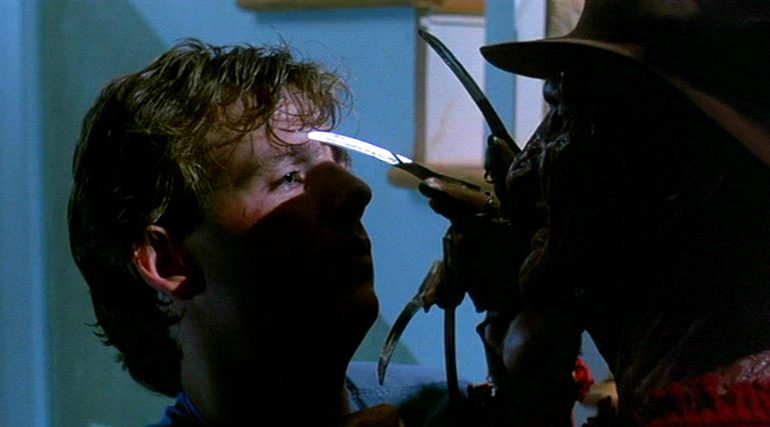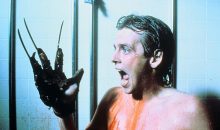The Coming Out of Freddy’s Revenge by Joshua Cross!!
From A Whisper To A Scream:
The ‘Coming Out’ of Freddy’s Revenge By: Joshua Cross
.
Since its onscreen birth in 1985, Freddy’s Revenge has undergone an undeniably queer transformation. In nothing short of movie magic – and nearly three decades of cultural evolution – the film considered by many as one of the worst horror sequels in history has become one of the most beloved of the Nightmare series, and certainly the most talked about throughout the last decade. What was once trashed and questioned over its ‘gayness’, has become loved and celebrated for its undeniably homosexual narrative. Not unlike the gay community itself, Freddy’s Revenge has fought a long and hard battle. Having been the most hated and misunderstood of the Nightmare canon, it is now the reason why many of us in the queer community have found our place at horror’s table. Freddy’s Revenge, the film and its history, has become synonymous with the term ‘queer horror’ and whether it’s the stories surrounding the film, or the film itself, it is a haunting lesson of the societal horrors of queerness and a poignant reminder of how far a movie – and culture – can come.
By 1985, nearly 6000 people had died of AIDS in the United States alone, thrusting the gay community into the limelight, for better or worse. Suddenly, homosexuality and queerness were a major part of daily social discussion and commentary; along with that homophobia and stigmatization were on the rise. Gays – in the eyes of the majority – were spreading a disease they had contracted through their own sexual perversions, killing each other by the thousands. We had become the monsters that the bigoted members of society had always claimed us to be. For many people, there was nothing scarier than the possibility that someone you knew could be gay. It is no secret that horror is a reflection of our fears in society, and when Freddy’s Revenge was created, there was nothing scarier or more terrifying for most of society than the gays and AIDS Epidemic.
Amidst one of the biggest epidemic horrors in American history, Robert Shaye, head of New Line Cinema, was eager to capitalize on his own tale of horror. A Nightmare on Elm Street had become New Line’s biggest hit and Shaye was dying – for lack of a better term – to turn the Wes Craven masterpiece into a money-making franchise. The follow-up was incredibly rushed and would come out less than a year after the original, without Craven. In his place, Jack Sholder, a New Line employee, came on to direct. Following him, the man who would set this whole story of gayness into motion: writer David Chaskin.
.
Like every North American in the 1980s, Chaskin was well aware of the AIDs crisis and found inspiration from it while writing Freddy’s Revenge, using the fear of being gay to drive the story of possession and repression. Although his themes and text would be obvious, Chaskin would deny the homosexual content for nearly twenty-five years, blaming those readings on the portrayal of Jesse Walsh, the film’s protagonist, by Mark Patton. At the time Patton was best known for playing a pre-transitioned Karen Black, and frequent victim of homophobic and transphobic violence, in Come Back To The Five And Dime, Jimmy Dean, Jimmy Dean, alongside Kathy Bates and the Queen of the Gays, Cher. Patton, himself homosexual, was forced to stay professionally-closeted at the insistence of Hollywood (being openly gay in 1985 Hollywood would have been career suicide). Regardless of how Patton portrayed Jesse Walsh, the fact remains that the film was written gay, and although most involved would deny picking up the homosexual subtexts, it wasn’t lost on everyone. However, it’s not completely unreasonable to think that many could be unaware of the sexual connotations, particularly amongst the overworked and rushed heterosexuals in the crew. It is still uncanny to think that scenes including naked towel whipping, sweaty writhing boys, and a “queer S&M joint”, couldn’t be seen as gay, however, the 80s were notoriously (and blindly) gay. There were, however, exceptions; most notably the production designer, who happened to be a gay man. This knowing is evidenced in many set pieces, including the infamous ‘Probe’ game in Jesse’s closet and a less noted (although arguably more important) copy of Jack Kerouac’s 1957 book “On The Road” on Jesse’s nightstand. The book is famous for its homoerotic themes and would have been an incredibly provocative read for a teen questioning his sexuality; including it was a very poignant and clever choice.
The film, at its essence, is about questioning one’s sexuality, the repression of said sexuality, and then – much to the dismay of many a gay viewer – heterosexual assimilation. The themes and concepts, hidden behind the face of Freddy in an attempted possession, were brought to the undeniable front, regardless of who was actually in on it. A movie such as Freddy’s Revenge could only have come out of a time like 1985, when queerness was blindly being appropriated by everyone from hair bands to men in crop tops, while simultaneously being stigmatized and villainized by the greater population. It was as if by some queer magic that Freddy’s Revenge had been born.
By the time Freddy’s Revenge came out on November 9th of 1985, the AIDS epidemic and society’s views on gays had worsened. Stigmatization was growing. Ryan White, a 13-year-old hemophiliac with AIDS, was barred from attending his middle school in Indiana. Rock Hudson had died a month earlier from AIDS, becoming the first major public figure to succumb to the disease. Among these real life horrors, Freddy’s Revenge became an even bigger hit than its predecessor, and solidified the Nightmare on Elm Street franchise. However, it would quickly be cast aside as New Line released three more sequels before the decade was through, positioning themselves as a major player in Hollywood, and creating one of the most iconic horror monsters in film history.
A Nightmare on Elm Street Part 2: Freddy’s Revenge would become a perfect allegory for what it meant to be gay in the 1980s. Ridiculed for being different, it would be cast out, and mostly ignored, by the horror community. Noted for deviating from the ‘rules’ of the rest of the series, it would be considered the worst of the franchise, occasionally being lamented for how ‘gay’ it was. As the AIDS epidemic subsided, so too would the subject of Freddy’s Revenge. David Chaskin would continue to deny any queer readings of Freddy’s Revenge, blaming Mark Patton’s acting. Patton, however, would be nowhere in sight to attest. After the traumatic experience of shooting Freddy’s Revenge and the backlash of the film’s perceived gayness (which were all pinned on him), Patton would be forced to stay in the closet. As those around him continued dying of AIDS, Mark Patton had had enough of the ignorance and hypocrisy and left Hollywood behind.
And so the story went for twenty-five years until a (not-so-little) documentary Never Sleep Again, whichchronicledtheentireNightmareseries,reintroducedMarkPattonandFreddy’s Revenge.
.
Coincidentally, the release fell in the middle of another major societal change for the queer community. This time, however, our story was not one of horrors and death, but of perseverance, acceptance, and love. Never Sleep Again introduced the world to the real queerness of Freddy’s Revenge at the same time Glee was teaching middle class America about queer rights, openly gay Adam Lambert was blowing up as a pop star, and Lady Gaga was writing Born This Way. Mark Patton would find the world he’d left behind was finally ready to hear his story and embrace it, much like the world was finally ready to do with the queer community.
Over the last decade, the queer community has changed drastically. Rights have been achieved, and we as a society have grown exponentially in the direction of acceptance. We’ve finally begun looking at our past, piecing together our historical and cultural narratives. The queer community’s relationship with horror has received its championing, with Freddy’s Revenge at the helm. Along with the film, Mark Patton’s story has opened the doors to a genre that has long been occupied by the LGBTQ community, and queerness in horror has become increasingly discussed, studied, and celebrated. From a ‘whisper to a scream’, “Queer Horror” is here to stay, and it has Freddy’s Revenge and Mark Patton to thank for it.





